Wincanton, Somerset
Up to 1834
In 1694, a charitable bequest led to the purchase of a large house on Wincanton common for use as a poorhouse. In 1735, a workhouse was opened in a former non-conformist chapel near Wincanton mill. By 1776, the workhouse could house up to 50 inmates. In 1800, the workhouse inmates were transferred to the poorhouse, with the workhouse building becoming derelict until being converted to housing in 1825.
A parliamentary report of 1777 recorded a parish workhouse operating at Charleton Musgrave for up to 24 inmates.
After 1834
The Wincanton Poor Law Union formally came into being on 30th December 1835. Its operation was overseen by an elected Board of Guardians, 43 in number, representing its 39 constituent parishes as listed below (figures in brackets indicate numbers of Guardians if more than one):
County of Somerset:
Abbas Combe and Temple Combe, Alford, Ansford or Almsford, Ashford, North Barrow, South Barrow, Blackford, Bratton, North Brewham, South Brewham, Bruton (2), North Cadbury, South Cadbury, Castle Cary (2), Charlton Horethorne, Charlton Musgrove, North Cheriton, Compton Pauncefoot, Corton Denham, Cucklington, Henstridge, Holton, Horsington, Lovington, Maperton, Milborne Port (2), Queen Camel, Penselwood, Pitcombe, Shepton Montague, Sparkford, Stoke Trister, Stowell, Sutton Montis or Montague, Weston Bampfylde, Wheathill, Wincanton (2), Yarlington.
County of Dorset:
Buckhorne Weston, Kington Magna.
Later Additions: Eastrip (1858-85), Four Towers (1858-85).
The population falling within the Union at the 1831 census had been 21,096 with parishes ranging in size from from Wheathill (population 56) to Wincanton itself (2,123). The average annual poor-rate expenditure for the period 1833-35 had been £14,796 or 14s.0d. per head of the population.
The new Wincanton Board of Guardians had its first meeting on New Year's Eve, 1835. On 4th May 1836, George Wilkinson was engaged to design a workhouse for 200 inmates, with the old parish poorhouse being used in the meantime. The Poor Law Commissioners subsequently authorised an expenditure of £3,300 on construction of the building which was then proposed to accommodate 140. His design was based on the model cruciform or "square" design published by the Commissioners in 1835. The new building, which was was completed in 1838, and the parish poorhouse was subsequently sold off and demolished.
The new workhouse had an entrance and administration block at the east. The ground at its front was cultivated by the inmates to supply vegetables for use in the workhouse.
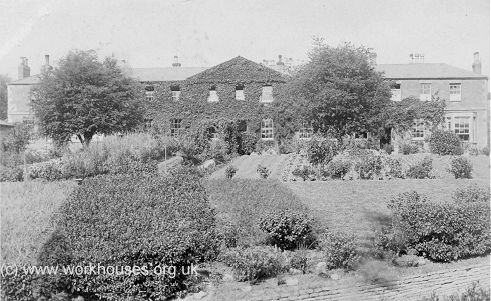
Wincanton workhouse from the east, 1908.
© Peter Higginbotham.
To the rear was a central octagonal hub, from which radiated four accommodation ranges between which lay separate exercise yards for the various classes of inmates. The site location and layout are shown on the 1880 map below.
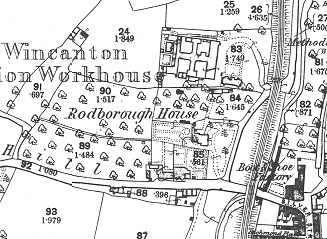
Wincanton Workhouse site, 1880.
In the early 1900s, the workhouse master was RW Copeman. Copeman also had a keen interest in stereoscopic photography where pairs of images, photographed slightly offset from one another, produce a 3-D effect when seen through a special viewer. Copeman became president of the Stereoscopic Society and many of his stereoscopic photographs survive, including a number of views taken in and around the workhouse.
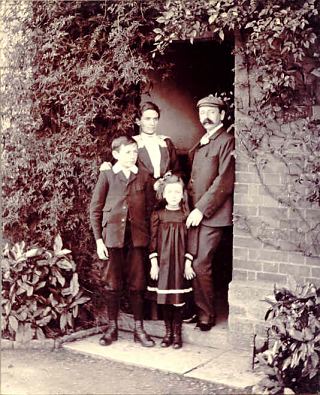
'With Christmas greetings and best wishes from Mr & Mrs R. W. Copeman. Town View Wincanton. Xmas 1904'
by RW Copeman, courtesy of Ray Norman.
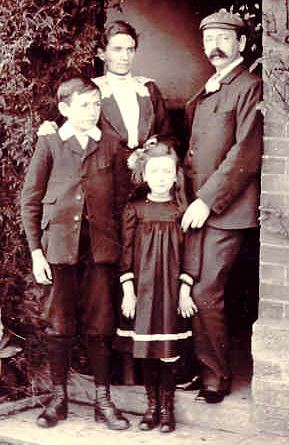
'Xmas 1904' (detail)
by RW Copeman, courtesy of Ray Norman.
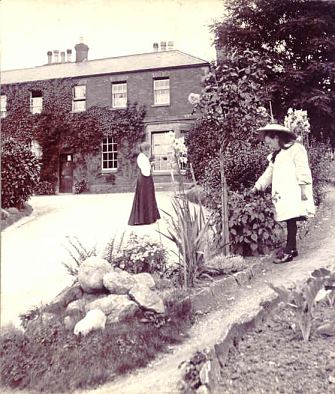
'Entrance Drive and Clerk's Office, July 1905'
by RW Copeman, courtesy of Ray Norman.
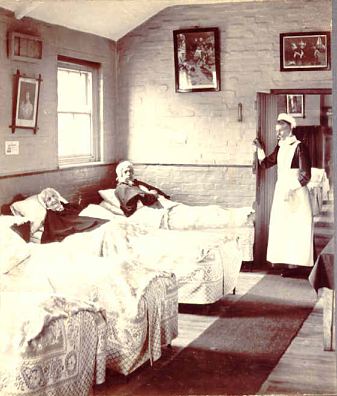
'A corner of the ward. 1904'
by RW Copeman, courtesy of Ray Norman.
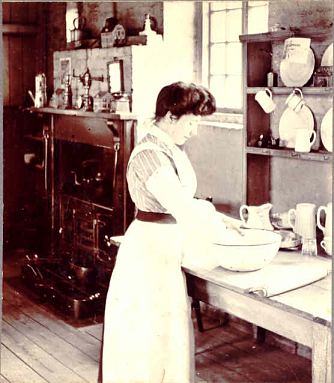
'The Cook (WN) at Workhouse. Feb. 1909'
by RW Copeman, courtesy of Ray Norman.
In 1914, following a directive from the Local Government Board, requiring that children no longer be permanently housed in workhouses, those from Wincanton were transferred to Rock Hill House on North Street. Soon afterwards, the girls were transferred to Linden Cottage, while the boys moved to Rodber House, just to the south of the workhouse.
The workhouse later became known as Town View and after 1930 served as an old people home until its closure in 1973 and subsequent demolition. A housing estate now stands on the site.
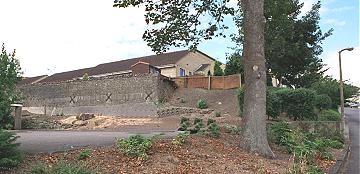
Wincanton workhouse site, 2000.
© Peter Higginbotham.
Children's Homes
The Wincanton Uion established several children's scattered homes in Wincanton. They were located at: Rock Hill House,23 North Street; Rodber House, Shadwell Lane (for boys); and Linden Cottages, North Street (for girls).
Staff
Inmates
Records
Note: many repositories impose a closure period of up to 100 years for records identifying individuals. Before travelling a long distance, always check that the records you want to consult will be available.
- Somerset Heritage Centre, Brunel Way, Langford Mead, Norton Fitzwarren, Taunton TA2 6SF. Holdings include: Guardians' minute books (1836-1930); Admissions and discharges (1836-1912, with gaps); Deaths (1866-1907); Creed register (1869-1930); Leave of absence book (1914-1919); etc.
Bibliography
- Higginbotham, Peter The Workhouse Encyclopedia (2014, The History Press)
Links
- None.
Acknowledgment
- Thanks to Ray Norman (www.worldofstereoviews.com) for RW Copeman material.
Unless otherwise indicated, this page () is copyright Peter Higginbotham. Contents may not be reproduced without permission.


